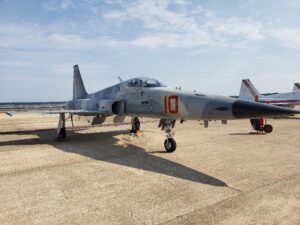The Navy reached a Milestone C decision last month on the program to reconfigure and modernize F-5 aircraft it bought from Switzerland to be used for adversary training, meaning it will next move to production and deployment.
The service’s Specialized and Proven Aircraft program office (PMA-226) F-5N+/F+ Avionics Reconfiguration and Tactical Enhancement/Modernization for Inventory Standardization (ARTEMIS) program seeks to convert and modernize 22 Northrop Grumman
[NOC] F-5 aircraft the Navy bought from the Swiss Air Force to be used in adversary training.
The Navy plans to use converted F-5E and F-5Fs, turned into the new designation F-5N+/F+, as well as F-16s acquired from the Air Force and Air National Guard, to replace Boeing [BA] F/A-18E/F Super Hornet reserve fighters previously used as opposition forces in training. This will allow the Navy to move those Super Hornets to the active fleet (Defense Daily, July 19, 2021).
The Navy said to meet the Navy and Marine Corps requirements as high-altitude tactical fighter adversary trainers “this program will reconfigure the airframe and incorporate a block upgrade consisting of emerging and existing commercial technology while capitalizing on industry’s private investment and lessons learned to upgrade necessary safety and capability features on the aircraft.”
The program office is configuring both the airframes and converting the F-5E/F engines to the Navy and Marine Corps standard F-5N/F. After that is finished, the program will integrate the block update, which covers a new glass cockpit and avionics suite matching modern aircraft technology.

“This program will provide a fleet of upgraded, safe and modernized adversary aircraft, providing the realistic and relevant tactical training that our aviators need to win in the fight,” Capt. Gregory Sutton, PMA-226 program manager, said in a statement.
The Navy’s Adversary Team is working with Tactical Air Support, Inc. as its industrial partner to perform the work.
Tactical Air Support currently owns and operates F-5AT aircraft supporting PMA-226 tactical fighter training and “has performed similar modernization and safety upgrades on its own fleet of aircraft,” the Navy said.
The company helped validate the block upgrade of the F-5s to become F-5N+/F+ configuration on two prototype Navy F-5Ns earlier this year, the service said.
The Navy recently awarded Tactical Air Support a $265 million contract to modify the full 22 Swiss F-5s, with work expected to be finished by June 2027 (Defense Daily, July 5).
“PMA-226’s Adversary Team drove to a successful milestone decision by challenging norms to tailor the program requirements using a blend of commercial solutions and the lessons learned by our industry partners with a focus on desired outcomes and risk mitigation,” Boyd Forsythe, PMA-226 F-5 Adversary Team lead, said.
The Navy previously delivered the first upgraded F-5N adversary fighter last September, whereupon it was sent to Naval Air Station Patuxent River, Md., to start ground and flight tests (Defense Daily, Sept. 21, 2021).
The F-5 was initially developed by Northrop Grumman in 1965 and offered as a candidate as a U.S. lightweight fighter. The aircraft later became popular as an export in the overseas market, including with the Swiss Air Force. The Navy previously purchased low-hour F-5E/F aircraft from the Swiss Air Force surplus in 2006 for use as adversary training aircraft. More recently, the Navy purchased this latest batch of Swiss F-5E/Fs bound for adversary training use in 2020.